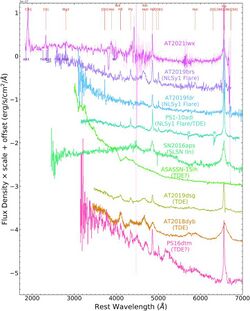Astronomy:AT 2021lwx


AT 2021lwx (also known as ZTF20abrbeie or "Scary Barbie"[2]) is the most energetic non-quasar optical transient astronomical event ever observed, with a peak luminosity of 7 × 1045 erg per second (erg s−1) and a total radiated energy of more than 1.5 × 1053 erg over three years.[1] Only GRB 221009A was more energetic, while also being far brighter. It was first identified in imagery obtained on 13 April 2021 by the Zwicky Transient Facility (ZTF) astronomical survey[3] and is believed to be due to the accretion of matter into a super massive black hole (SMBH) heavier than one hundred million solar masses (M☉).[2][1][4] It has a redshift of z = 0.9945,[1] which would place it at a distance of about eight billion light-years from earth,[4] and is located in the constellation Vulpecula.[5] No host galaxy has been detected.[2][1]
Forced photometry of earlier ZTF imagery showed AT 2021lwx had already begun brightening by 16 June 2020, as ZTF20abrbeie. It was also detected independently in data from the Asteroid Terrestrial-impact Last Alert System (ATLAS) as ATLAS20bkdj, and the Panoramic Survey Telescope and Rapid Response System (Pan-STARRS) as PS22iin. At the Neil Gehrels Swift Observatory, X-ray observations were made with the X-ray Telescope and ultraviolet, with the Ultraviolet-Optical Telescope (UVOT).[2][1]
Subrayan et al. originally interpreted it to be a tidal disruption event between an SMBH (~108 M☉) and a massive star (~14 M☉).[2] Wiseman et al. disfavor this interpretation, and instead believe the most likely scenario is "the sudden accretion of a large amount of gas, potentially a giant molecular cloud"[1] (~1,000 M☉),[6] onto an SMBH (>108 M☉).[1][7]
The inferred mass of the SMBH, based on the light to mass ratio, is about 1 hundred million - 1 billion solar masses, given the observed brightness. However, the theoretical limit for an accreting super massive black hole is 1 hundred million solar masses. Given the best understood model of accreting SMBH's, this even may be the most massive SMBH to possibly accrete matter.[8] [citation needed]
See also
- Ophiuchus Supercluster eruption, a 5 × 1061-erg event that may have occurred up to 240 million years ago, revealed by a giant radio fossil
- MS 0735.6+7421, a 1061-erg eruption that has been occurring for the last 100 million years
- GRB 080916C, an 8.8 × 1054-erg gamma-ray burst seen in 2008[9]
- GRB 221009A, a 1.2 × 1055-erg gamma-ray burst seen in 2023[10]
- Astronomy:Hypernova – Supernova that ejects a large mass at unusually high velocity
References
- ↑ 1.0 1.1 1.2 1.3 1.4 1.5 1.6 1.7 1.8 Wiseman, p.; Wang, Y.; Hönig, S.; Castero-Segura, N.; Clark, P.; Frohmaier, C.; Fulton, M. D.; Leloudas, G. et al. (July 2023). "Multiwavelength observations of the extraordinary accretion event AT 2021lwx". Monthly Notices of the Royal Astronomical Society 522 (3): 3992–4002. doi:10.1093/mnras/stad1000.
- ↑ 2.0 2.1 2.2 2.3 2.4 Subrayan, Bhagya M.; Milisavljevic, Dan; Chornock, Ryan; Margutti, Raffaella; Alexander, Kate D.; Ramakrishnan, Vandana; Duffell, Paul C.; Dickinson, Danielle A. et al. (2023-05-01). "Scary Barbie: An Extremely Energetic, Long-duration Tidal Disruption Event Candidate without a Detected Host Galaxy at z = 0.995". The Astrophysical Journal Letters 948 (2): L19. doi:10.3847/2041-8213/accf1a. ISSN 2041-8205. Bibcode: 2023ApJ...948L..19S.
- ↑ J. Nordin, V. Brinnel, J. van Santen, A. Gal-Yam, O. Yaron, S. Schulze (10 May 2021). "Discovery certificate for object 2021lwx". IAU Transient Name Server.
- ↑ 4.0 4.1 Overbye, Dennis (12 May 2023). "The Biggest Explosion in the Cosmos Just Keeps Going - For three years, telescopes have monitored "one of the most luminous" events ever: a supermassive black hole consuming a gigantic cloud of interstellar gas.". The New York Times. Archived from the original on 12 May 2023. https://archive.today/20230512191540/https://www.nytimes.com/2023/05/12/science/astronomy-black-hole.html. Retrieved 13 May 2023.
- ↑ "Astronomers reveal the largest cosmic explosion ever seen". 5 November 2023. https://ras.ac.uk/news-and-press/news/astronomers-reveal-largest-cosmic-explosion-ever-seen.
- ↑ "This Is The Largest Cosmic Explosion In The Universe Ever Seen" (in en). 2023-05-11. https://www.iflscience.com/this-is-the-largest-cosmic-explosion-in-the-universe-ever-seen-68893.
- ↑ "'Terrifying': Why the universe's largest cosmic explosion is called 'Scary Barbie'" (in en-US). https://www.usatoday.com/story/news/nation/2023/05/12/largest-space-explosion-scary-barbie-black-hole/70212322007/.
- ↑ Mockler, Brenna; Guillochon, James; Ramirez-Ruiz, Enrico (2019-02-20). "Weighing Black Holes Using Tidal Disruption Events" (in en-us). The Astrophysical Journal 872 (2): 151. doi:10.3847/1538-4357/ab010f. Bibcode: 2019ApJ...872..151M.
- ↑ Fermi LAT and Fermi GBM Collaborations (27 March 2009). "Fermi Observations of High-Energy Gamma-Ray Emission from GRB 080916C". Science 323 (5922): 1688–1693. doi:10.1126/science.1169101. PMID 19228997. Bibcode: 2009Sci...323.1688A.
- ↑ Burns, Eric; Svinkin, Dmitry; Fenimore, Edward; Kann, D. Alexander; Agüí Fernández, José Feliciano; Frederiks, Dmitry; Hamburg, Rachel; Lesage, Stephen et al. (2023-03-01). "GRB 221009A: The BOAT". The Astrophysical Journal Letters 946 (1): L31. doi:10.3847/2041-8213/acc39c. ISSN 2041-8205. Bibcode: 2023ApJ...946L..31B.
 |

